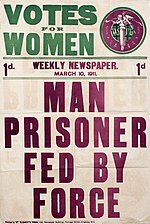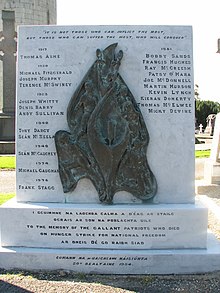Hunger strike

Ahunger strikeis a method ofnon-violent resistancewhere participantsfastas an act of politicalprotest,usually with the objective of achieving a specific goal, such as a policy change.[1][2]Most hunger strikers will take liquids but not solid food.[citation needed]Hunger strikers that do not take fluids are nameddry hunger strikers.[3]
In cases where an entity (usually thestate) has or is able to obtain custody of the hunger striker (such as aprisoner), the hunger strike is often terminated by the custodial entity through the use offorce-feeding.[4]
Early history[edit]
Fasting was used as a method of protesting injustice in pre-ChristianIreland,where it was known asTroscadhorCealachan.[5]Detailed in the contemporarycivic codes,it had specific rules by which it could be used, and the fast was often carried out on the doorstep of the home of the offender.[6]Scholars speculate that this was due to the high importance the culture placed on hospitality. Allowing a person to die at one's doorstep, for a wrong of which one was accused, was considered a great dishonor.[7]Others say that the practice was to fast for one whole night, as there is no evidence of people fasting to death in pre-Christian Ireland. The fasts were primarily undertaken to recover debts or get justice for a perceived wrong. Legends ofSaint Patrick,the patron saint of Ireland, have used the hunger strike as well.[8]
InIndia,the practice of a hunger protest, where the protester fasts at the door of an offending party (typically a debtor) in a public call for justice, was abolished by the government in 1861; this indicates the prevalence of the practice prior to that date, or at least a public awareness of it.[8]
Medical view[edit]
In the first three days, the body still uses energy fromglucose.[9]After that, theliverstarts processingbody fat,in a process calledketosis.After depleting fat, the body enters a "starvationmode ".[9]At this point the body "mines" the muscles and vital organs for energy, and loss ofbone marrowbecomes life-threatening. There are examples of hunger strikers dying after 46 to 73 days of strike, for example the1981 Irish hunger strike.[8]Hunger strikers can experience hallucinations[10]anddelirium.[11]Death usually occurs when a hunger striker has lost about 40–50% of their pre-strike weight at about 60–70 days in.[12]Obese individuals can last longer.[13]
Examples[edit]
The examples and perspective in this sectionmay not represent aworldwide viewof the subject.(January 2024) |
British and American suffragettes[edit]


In the early 20th centurysuffragettesfrequently endured hunger strikes in British prisons.Marion Dunlopwas the first in 1909. She was released, as the authorities did not want her to become amartyr.Other suffragettes in prison also undertook hunger strikes. The prison authorities subjected them to force-feeding, which the suffragettes categorized as a form oftorture.Emmeline Pankhurst's sisterMary Clarkedied shortly after being force-fed in prison, and others includingLady Constance Bulwer-Lyttonare believed to have had serious health problems caused by force feeding, dying of aheart attacknot long after.[14]William Ball,a working class supporter of women's suffrage, was the subject of a pamphletTorture in an English Prisonnot only due to the effects of force-feeding, but a cruel separation from family contact and mental health deterioration, secret transfer to a lunatic asylum and needed lifelong mental institutional care.[15]In December 1912, a Scottish prison put four suffragettes in the 'political prisoner' category rather than 'criminal' second division, but staff atCraiginches Prison,Aberdeen still subjected them to force-feeding when they went on hunger strike.[16]
In 1913 thePrisoners (Temporary Discharge for Ill Health) Act 1913(nicknamed the "Cat and Mouse Act" ) changed policy. Hunger strikes were tolerated but prisoners were released when they became sick. When they had recovered, the suffragettes were taken back to prison to finish their sentences. About 100 women receivedmedalsfor hunger striking or enduring force-feeding.[citation needed]
Like their British counterparts, American suffragettes also used this method of political protest. A few years before the passage of theNineteenth Amendment to the United States Constitution,a group of American suffragettes led byAlice Paulengaged in a hunger strike and endured forced feedings while incarcerated at theOccoquan Workhousein Virginia.[citation needed]
Ireland[edit]

Hunger strikes have deep roots in Irish society and in the Irish psyche. Fasting in order to bring attention to an injustice which one felt under his lord, and thus shame him, was a common feature ofearly Irishsociety and this tactic was fully incorporated into theBrehonlegal system. The tradition is ultimately most likely part of the still older Indo-European tradition of which the Irish were part.[17][18]Within the 20th century a total of 22 Irish republicans died on hunger strike with survivors suffering long-term health and psychological effects.
The tactic was used byphysical force republicansduring the1916–23 revolutionary period.Early use of hunger strikes was countered withforce-feeding,culminating in 1917 in the death ofThomas AsheinMountjoy Prison.During theAnglo-Irish war,in October 1920, theLord MayorofCork,Terence MacSwiney,died on hunger strike inBrixton prison.At the same time, the1920 Cork hunger striketook place. Two other CorkIrish Republican Army(IRA) men,Joe MurphyandMichael Fitzgerald,died in this protest. Demanding reinstatement of political status and release from prison, nine men undertook a hunger strike atCork County Gaolfor 94 days, from August 11 to November 12, 1920.[19][20]Arthur Griffithcalled off the strikes after the deaths of MacSwiney, Murphy and Fitzgerald.
During the early 1920s, the vesselHMSArgentawas used as aprison shipfor the holding ofIrish republicansby the British. Conditions on board were "unbelievable"[21]and there were several hunger strikes, including one involving upwards of 150 men in the winter of 1923.[22]
Irish hunger strikes between 1923 and 1976[edit]
In February 1923, 23 women (members of Cumann na mBan) went on hunger strike for 34 days over the arrest and imprisonment without trial of Irish republican prisoners. The Free State subsequently released the women republican prisoners. Most of the male republicans were not released until the following year.[23]After the end of theIrish Civil Warin October 1923, up to 8,000IRAprisoners went on hunger strike to protest their continued detention by theIrish Free State(a total of over 12,000 republicans had been interned by May 1923).[24]Three men,Denny Barry,Joseph Whitty,andAndy O'Sullivan,died during the 1923 Irish Hunger Strikes. The strike, however, was called off by Republican leadership in the camps (November 23, 1923) before any more deaths occurred.
Underde Valera'sfirst Fianna Fáil governmentin 1932, military pensions were awarded to dependants of republicans who died in 1920s hunger strikes on the same basis as those who werekilled in action.[25]Duringthe state of emergencyofWorld War IIanother De Valera governmentinterned many IRA members, three of whom died on hunger strike:Sean McCaughey,Tony D'ArcyandJack McNeela.Hundreds of others carried out shorter hunger strikes during the de Valera years.
The tactic was revived by theProvisional Irish Republican Army(IRA) in the early 1970s, when several republicans successfully used hunger strikes to get themselves released from custody without charge in theRepublic of Ireland.Michael Gaughandied after being force-fed inParkhurst Prisonin 1974.Frank Stagg,an IRA member being held inWakefield Prison,died in 1976 after a 62-day hunger strike which he began as a campaign to berepatriatedto Ireland.[26][27]
Members of other movements likeHolger Meinsof GermanRed Army Fractionused hunger strikes as a political weapon at this time. Meins went on hunger strike for the first time in 1973 together with other prisoners in protest against the prison conditions. The RAF prisoners wanted to be pooled together and claimed prisoner of war status. The 1.83m tall Meins still weighed 39 kg in November 1973 and died in prison.[28]
Irish hunger strike of 1981[edit]
In 1980, seven Irish Republican prisoners, six from the IRA and one from theIrish National Liberation Army,in theMaze Prisonlaunched a hunger strike as a protest against the revocation by theBritish Governmentof aprisoner-of-war-likeSpecial Category Statusforparamilitaryprisoners inNorthern Ireland.[29][30]The strike, led byBrendan Hughes,was called off before any deaths, when the British government seemed to offer to concede their demands; however, the British Government then reneged on the details of the agreement. The prisoners then called another hunger strike the following year. This time, instead of many prisoners striking at the same time, the hunger strikers started fasting one after the other in order to maximise publicity over the fate of each one.[31]
Bobby Sandswas the first of ten Irish republicanparamilitaryprisoners to die after 66 days during the 1981 hunger strike, withMickey Devinebeing the last to die after 60 days. There was widespread sympathy for the hunger strikers from Irish republicans and the broadernationalistcommunity on both sides of theIrish border.Sands was elected as an MP forFermanagh and South Tyroneto the United Kingdom'sHouse of Commonsand two other prisoners,Paddy Agnew(who was not a hunger striker) andKieran Doherty,were elected toDáil Éireannin theRepublic of Irelandby electorates who wished to register their opposition to the British Government's policy. The ten men survived without food for 46 to 73 days,[32]taking only water and salt, before succumbing. After the deaths of the men and severe public disorder, the British Government granted partial concessions to the prisoners, and the strike was called off. The hunger strikes gave a significantpropagandaboost to a previously severely demoralised IRA.
Gandhi and Bhagat Singh[edit]

Mahatma Gandhiwas imprisoned in 1908, 1909, 1913, 1917, 1919, 1922, 1930, 1932, 1933, and 1942.[33]Because of Gandhi's stature around the world, British authorities were loath to allow him to die in their custody; Gandhi engaged in several famous hunger strikes to protestBritish rule in India.
In addition to Gandhi, various others used the hunger strike option during the Indian independence movement, includingJatin Das,who fasted to death, andBhagat SinghandBatukeshwar Duttin 1929[34]
Potti Sriramulu[edit]
In 1952, in independent India, revolutionaryPotti Sriramuluundertook a hunger strike for 56 days in an attempt to achieve the formation of a separate state, to be known asAndhra State.His death on December 15 became instrumental in thelinguistic re-organisation of states.[35]
He is revered asAmarajeevi(Immortal being) in Coastal Andra for his role in achieving the linguistic re-organisation of states. As a devout follower ofMahatma Gandhi,he worked for much of his life to uphold principles such as truth, non-violence and patriotism, as well as causes such asHarijanmovement to end the traditional alienation of, and accord respect and humane treatment to those traditionally called "untouchables"in Indian society.[35]
Cuban dissidents[edit]
On April 3, 1972,Pedro Luis Boitel,an imprisoned poet and dissident, declared himself on hunger strike. After 53 days on hunger strike, receiving only liquids, he died of starvation on May 25, 1972. His last days were related by his close friend, poetArmando Valladares.He was buried in an unmarked grave in theCólon CemeteryinHavana.[citation needed]
Guillermo Fariñasdid a seven-month hunger strike to protest against the extensiveInternet censorship in Cuba.He ended it in Autumn 2006, with severe health problems although still conscious.[36]Reporters Without Bordersawarded its cyber-freedom prize to Guillermo Fariñas in 2006.[37]
Jorge Luis García Pérez(known as Antúnez) has done hunger strikes. In 2009, following the end of his 17-year imprisonment, Antúnez, his wife Iris, and Diosiris Santana Pérez started a hunger strike to support other political prisoners. Leaders from Uruguay, Costa Rica, and Argentina declared their support for Antúnez.[38][39]
On February 23, 2010,Orlando Zapata,a dissident arrested in 2003 as part of a crackdown on opposition groups, died in a hospital while undertaking a hunger strike that had been ongoing for 85 days. His hunger strike was a protest against poor prison conditions. Amnesty International had declared him a prisoner of conscience.[40]
Legal situation[edit]
Article 8 of the 1975World Medical AssociationDeclaration of Tokyostates that doctors are not allowed to force-feed hunger strikers. They are supposed to understand the prisoner's independent wishes, and it is recommended to have a second opinion as to the capability of the prisoner to understand the implication of their decision and be capable of informed consent.
- Where a prisoner refuses nourishment and is considered by the physician as capable of forming an unimpaired and rational judgement concerning the consequences of such a voluntary refusal of nourishment, they shall not be fed artificially. The decision as to the capacity of the prisoner to form such a judgement should be confirmed by at least one other independent physician. The consequences of the refusal of nourishment shall be explained by the physician to the prisoner.[41]
The World Medical Association (WMA) recently revised and updated its Declaration of Malta on Hunger Strikers.[42]Among many changes, it unambiguously states that force feeding is a form of inhumane and degrading treatment in its Article 21.
TheAmerican Medical Association(AMA) is a member of the WMA, but the AMA's members are not bound by the WMA's decisions, as neither organization has formal legal powers. The AMA has formally endorsed the WMA Declaration of Tokyo and has written several letters to the US government and made public statements in opposition to US physician involvement in force feeding of hunger strikers in contravention of medical ethics.[43]The United StatesCode of Federal Regulationsrule on hunger strikes by prisoners states, "It is the responsibility of the Bureau of Prisons to monitor the health and welfare of individual inmates, and to ensure that procedures are pursued to preserve life." It further provides that when "a medical necessity for immediate treatment of a life or health threatening situation exists, the physician may order that treatment be administered without the consent of the inmate."[44]
See also[edit]
References[edit]
- ^Engelbrecht, Cora (May 2, 2023)."Hunger Strikes Have Long Served as a Tool of Nonviolent Protest".The New York Times.ISSN0362-4331.Archivedfrom the original on January 29, 2024.RetrievedJanuary 29,2024.
- ^"Hunger strike definition and meaning".collinsdictionary.Collins English Dictionary.Archivedfrom the original on April 6, 2015.RetrievedOctober 21,2021.
- ^Foltynova, Kristyna."Anatomy Of A Hunger Strike: Why Is It Done And What Does It Do To The Human Body?".RadioFreeEurope/RadioLiberty.RetrievedMarch 25,2024.
- ^Savage, Charlie (October 11, 2017)."Military Is Waiting Longer Before Force-Feeding Hunger Strikers, Detainees Say".The New York Times.ISSN0362-4331.Archivedfrom the original on January 29, 2024.RetrievedJanuary 29,2024.
- ^Ellis, Peter Bereford. The Druids (Eerdmans, 1998). pp. 141–142.
- ^Chisholm, Hugh,ed. (1911)..Encyclopædia Britannica.Vol. 4 (11th ed.). Cambridge University Press. p. 490.
- ^Joyce, Patrick Weston, A Smaller Social History of ancient Ireland (Longman, Green & Co, 1906), Chapter IV: The Administration of Justice, p.86. Found online athttps:// libraryireland /SocialHistoryAncientIreland/I-IV-6.phpArchivedFebruary 24, 2020, at theWayback Machine
- ^abcBeresford, David (1987).Ten Men Dead.New York: Atlantic Press.ISBN978-0-87113-702-9.[page needed]
- ^abCoffee, C. J. (2004).Quick Look: Metabolism.Hayes Barton Press. p. 169.ISBN978-1593771928.
- ^Miller, Ian (2018).Medical History.Bloomsbury Publishing.
- ^Psychiatry in Prisons A Comprehensive Handbook.Jessica Kingsley. 2018. p. 156.
- ^Stevenson, R. J., & Prescott, J. (2014). Human diet and cognition. Wiley Interdisciplinary Reviews: Cognitive Science, 5(4), 463–475.
- ^Johnstone A. Fasting the ultimate diet. Obes Rev 2007, 8:211–222.
- ^Wilson, Simon; Ian Cumming (2009).Psychiatry in Prisons: A Comprehensive Handbook.Jessica Kingsley Publishers. p.156.ISBN978-1843102236.
- ^Atkinson, Diane (2018).Rise up, women!: the remarkable lives of the suffragettes.London: Bloomsbury. pp. 289, 293.ISBN9781408844045.OCLC1016848621.
- ^Pedersen, Sarah."The Aberdeen Women's Suffrage Campaign".suffrageaberdeen.co.uk.copyright WildFireOne.Archivedfrom the original on March 18, 2023.RetrievedMarch 18,2023.
- ^D.A. Binchy,"A Pre-Christian Survival in Mediaeval Irish Hagiography", inIreland in Early Mediaeval Europe(Cambridge University Press, 1982), pp. 168–178
- ^Rudolf Thurneysen,"Das Fasten beim Pfändungsverfahren",Zeitschrift für Celtische Philologie15 (1924–25) 260–275.
- ^"END HUNGER STRIKE OF CORK PRISONERS; Sinn Féin Leader Absolves Them and They Take Food After 94 Days' Fast. AMBUSH FIVE JOURNALISTS Soldiers Kill Two and Capture Seven of the Attackers—Mrs. MacSwiney Coming Here"(PDF).The New York Times.November 13, 1920.Archived(PDF)from the original on February 25, 2021.RetrievedJune 14,2018.
- ^Guinness Book of Records 1988,p. 21
- ^Kleinrichert, Denise (2001).Republican internment and the prison ship Argenta 1922.Irish Academic Press.ISBN978-0-7165-2683-4.
- ^Hopkinson, Michael (2004).The Irish War of Independence.M.H. Gill & Company U. C.ISBN978-0-7171-3741-1.
- ^McCarthy, Pat, (2015),The Irish Revolution, 1912–1923,Four Courts Press, Dublin, p.132, ISBN 978-1-84682-410-4
- ^The Forgotten Hunger Strikes ". hungerstrikes.org.
- ^"Army Pensions Act, 1932, Section 5(2)".Irish Statute Book.Archivedfrom the original on October 31, 2017.RetrievedJuly 17,2017.
the word "killed" includes... death as an immediate result of refusing to take nourishment while detained in prison
- ^White, Robert (2006).Ruairí Ó Brádaigh: The Life and Politics of an Irish Revolutionary.Indiana University Press.pp. 246–247.ISBN978-0253347084.
- ^O'Donnell, Ruán (2012).Special Category: The IRA in English Prisons Vol.1: 1968–78.Irish Academic Press.p. 364.ISBN978-0-7165-3142-5.
- ^Sontheimer, Michael (November 8, 2007)."RAF".Der Spiegel(in German).ISSN2195-1349.RetrievedJune 3,2024.
- ^White, Robert (2017).Out of the Ashes: An Oral History of the Provisional Irish Republican Movement.Merrion Press. p. 173.ISBN9781785370939.
- ^Dillon, Martin(1991).The Dirty War.Arrow Books.p. 288.ISBN978-0-09-984520-1.
- ^Taylor, Peter(1997).Provos The IRA & Sinn Féin.Bloomsbury Publishing.p. 237.ISBN0-7475-3818-2.
- ^"The Starry Plough on 1981 Irish hunger strikes"(PDF).Archived(PDF)from the original on February 24, 2013.RetrievedJune 22,2006.
- ^"Years of Arrests & Imprisonments of Mahatma Gandhi | Chronology of Mahatma Gandhi".mkgandhi.org.Archivedfrom the original on September 20, 2022.RetrievedSeptember 19,2022.
- ^"Bhagat Singh: Latest News, Videos and Photos of Bhagat Singh | Times of India".The Times of India.Archivedfrom the original on November 3, 2023.RetrievedNovember 3,2023.
- ^abMary, S. B. Vijaya (December 13, 2022)."Actor Saichand pays tribute to Potti Sriramulu on his 70th death anniversary".The Hindu.ISSN0971-751X.Archivedfrom the original on November 3, 2023.RetrievedNovember 3,2023.
- ^"Guillermo Fariñas ends seven-month-old hunger strike for Internet access".Reporters Without Borders. January 20, 2016.Archivedfrom the original on November 20, 2018.RetrievedNovember 20,2018.
- ^"Cyber-freedom prize for 2006 awarded to Guillermo Fariñas of Cuba".Reporters Without Borders. January 20, 2016.Archivedfrom the original on November 20, 2018.RetrievedNovember 20,2018.
- ^"Additional Latin American Leaders Join in Solidarity with Antúnez".Archived fromthe originalon October 27, 2012.
- ^"Young Uruguayans Support Antúnez, Cuban Political Prisoners".Archived fromthe originalon October 27, 2012.
- ^"Cuban prison hunger striker Orlando Zapata Tamayo dies".BBC News.February 24, 2010.Archivedfrom the original on November 14, 2017.RetrievedFebruary 24,2010.
- ^"WMA – the World Medical Association – WMA DECLARATION OF TOKYO – GUIDELINES FOR PHYSICIANS CONCERNING TORTURE AND OTHER CRUEL, INHUMAN OR DEGRADING TREATMENT OR PUNISHMENT IN RELATION TO DETENTION AND IMPRISONMENT".Archivedfrom the original on January 17, 2020.RetrievedJanuary 28,2020.
- ^"WMA – the World Medical Association-WMA Declaration of Malta on Hunger Strikers".Archivedfrom the original on August 29, 2017.RetrievedAugust 29,2017.
- ^"American Medical Association Opposes Force-Feeding Prisoners On Hunger Strike At Gitmo".ThinkProgress.Archivedfrom the original on October 6, 2014.RetrievedOctober 2,2014.
- ^"Title 28: Judicial Administration".Electronic Code of Federal Regulations. Archived fromthe originalon June 12, 2011.RetrievedSeptember 1,2010.
External links[edit]
- "Hunger Strikes, Force-feeding, and Physicians' Responsibilities"
- Fasting as a Method To Demand International Protection For the People of Darfur, Sudan
- Bibliography on hunger strikes and force-feeding in the IFHHRO Right to Health Wiki
- "The long history of the Irish hunger strike: New exhibition in Kilmainham Gaol tells the story from Thomas Ashe to Bobby Sands" Irish Times 2017-09-21
